|
Most long rodders come to the salt by way of
the trout stream, and they tend to leave their
good habits, like line mending and dead drifting,
behind, while bringing along the bad habit of
attempting to carry an entire fly shop with
them on each and every excursion. It's
understandable; old habits die hard and they
still have that recurring nightmare about the
time the trout were rising to Hexagenia
and they only had Potamanthus. If
you're new to the salt and this describes you,
now is your chance to break that routine and
shed a few pounds. You'll be grateful you did,
seeing that you'll be casting twice the line
weight that you're used to.
First, lose the vest. All of those pockets are
begging to be filled, and everything in the salt
is magnified (including the fish!) and you'll
find the vest inadequate. Replace the vest with
a chest pack or shoulder bag, but not one the
size of a suitcase. Think of what you'll need;
one fly box (no, not one dry fly, one nymph,
one streamer and one midge box, just one box!),
one spool of leader material (not every size form
0x to 6x), a pair of nippers, a pair of forceps,
and a piece of lead line. That's it - only one
pocket of your vest!
A great, cheap chest pack is the Eastport travel
bag, sold at Walmart for $7.00. It's made of
cordura, has a nylon zipper, two large and two
small pockets, and will hold everything you need.
You'll find it in the purse section, because the
manufacturer thinks it's a ladies purse, but we
salt rodders know better.
Fish a floating line and forget about spare
spools -- if you've invested big bucks in a reel
with a decent drag, chances are you won't be able
to change spools streamside anyway. If the fish
are deep, add the lead line (with a loop to loop
connection) to get the fly down. Carry one spool
of 20 lb. test, and use a straight leader six to
nine feet long. I've had a lot of luck with Berkley
Vanish fluorocarbon, and the cost is only $9.00 for
175 yards, more than enough to last two seasons.
Keep a loop (I like the bimini) tied to the tag
end of the line on the spool-if you need to change
you leader you can just peel off the amount you need,
cut it, and attach it to the loop on the fly line.
Carry one large fly box with flies suited to the
type of fishing you'll be doing. You should start
with a few clousers, a few deceivers (colors white,
black, and chartreuse), a few Ray's flies, and maybe
a surface fly like Gartside's gurgler in sizes 1/0
and 2/0. Change your fly box for different fishing
situations; darker flies for night fishing, shrimp,
crab, and clam worms for estuary fishing, weighted
flies for fishing rips.
Buy a cheap pair of nippers (nail clippers work well)
and hook them to the zipper of your chest pack.
They'll be handy when you need them and will make
opening your chest pack a bit easier. Fasten the
forceps to the backside of your chest pack to keep
them out of the way until you need them. Leave the
$135 pliers at home.
The last thing you'll need, if you plan to fish
at night, is a waterproof flashlight. My favorite
is UK2AAA from Underwater Kinetics. It's bright,
small, clips to the bill of your cap, and is
waterproof to 100 meters, which I can attest to
as I once dropped one in a strong rip and followed
its beam of light as it headed to England.
That's it. Take the money you've saved and buy a
new streamside thermometer, or a fish stomach pump,
or some other essential piece of gear to squeeze in
your vest. Just leave it all at home when you head
to the salt. ~ Dave
About Dave:
 Dave Micus lives in Ipswich, Massachusetts. He is an
avid striped bass fly fisherman, writer and instructor.
He writes a fly fishing column for the Port City Planet
newspaper of Newburyport, MA (home of Plum Island and Joppa Flats)
and teaches a fly fishing course at Boston University.
Dave Micus lives in Ipswich, Massachusetts. He is an
avid striped bass fly fisherman, writer and instructor.
He writes a fly fishing column for the Port City Planet
newspaper of Newburyport, MA (home of Plum Island and Joppa Flats)
and teaches a fly fishing course at Boston University.
|

 Dave Micus lives in Ipswich, Massachusetts. He is an
avid striped bass fly fisherman, writer and instructor.
He writes a fly fishing column for the Port City Planet
newspaper of Newburyport, MA (home of Plum Island and Joppa Flats)
and teaches a fly fishing course at Boston University.
Dave Micus lives in Ipswich, Massachusetts. He is an
avid striped bass fly fisherman, writer and instructor.
He writes a fly fishing column for the Port City Planet
newspaper of Newburyport, MA (home of Plum Island and Joppa Flats)
and teaches a fly fishing course at Boston University.